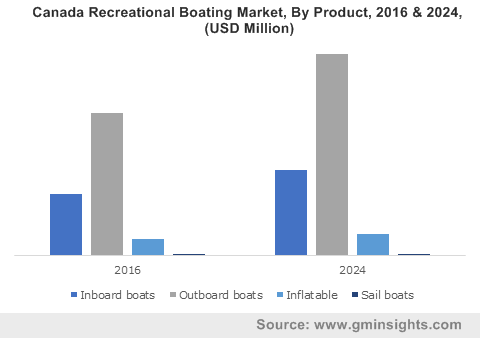Outboard recreational boating market to register commendable gains over 2017-2024, highly advanced tech innovations to stimulate the industry growth
Publisher : Fractovia | Published Date : April 2018Request Sample
With the definition of outdoor recreation changing massively in the last few years, recreational boating market has emerged as one sector that has witnessed a profound impact. Incidentally, this business space is highly regulatory driven, as is evidenced by the involvement of legislative bodies such as National Marine Manufacturers Association (NMMA) of U.S. Indeed, the NMMA is working toward increasing the visibility for recreational boating industry, claiming that the growth of the overall recreation sector is pivotal for the American economy.
U.S. Recreational Boating Market, By Product, 2016 & 2024, (Units)

According to the NMMA, a strong dollar, lowering of fuel prices, and lower interest rates had increased boat sales in the U.S. by 3% in 2016. On these grounds, NMMA has apparently even demanded an increased investment by the U.S. government in the recreation sector, that would eventually push recreational boating market toward greater heights of development in the ensuing years. Quite ironically though, this business sphere had observed a slightly sluggish growth graph during recession, it rose prominently post the dismal period, faring better than it earlier.
Outboard, inboard and hybrid engines and concerns for the environment
Most recreational boat categories, including the likes of pontoons, PWC, saltwater fishing boats, outboard-powered runabouts, and ski boats have now been witnessing a consistency in demand. It therefore, comes as no surprise that outboard recreational boating market size has been forecast to be pegged at $135 billion by 2024. One of the pivotal driving factors for this exceptional growth is the cost effectiveness of the product and easy maintenance. Not to mention, these boats have increased usable space with their engines mounted on a highly convenient position, further helping toward impelling outboard recreational boating industry share.
It is worthy to mention that with rising concerns about climatic changes, recreational boating industry participants have been directing their concerns at developing greener ways to satiate the increasing number of ecologically conscious customers. With the U.S. Environmental Protection Agency tightening its emission standards for marine engines, hybrid boats have made profitable inroads into recreational boating industry. For instance, the Endeavor Green Electric Hybrid is charged electrically and can run all day at a cost of merely 11 cents without generating any emissions. It even gives the owner the option to charge with wind or electric power and leaves zero carbon footprint.
Another instance is the 25-foot Frauscher hybrid, which is currently making waves in recreational boating market. The product combines 256 horsepower Steyr diesel motor with an electric engine for emission free high-octane speeding – an outstanding launch in the overall industry.
Besides hybrid boats, man-powered boats are also ecofriendly considering that they involve no engines at all. Indeed, man powered recreational boating industry size is anticipated to register a CAGR of 4% over 2017-2024. However, the growing popularity for man-powered boats could be attributed more to the rising demand for boating adventure sports like river rafting and kayaking rather than concerns for the environment. Besides, man-powered boats are witnessing greater demand from a growing populace of health-conscious consumers who view recreational boating as a very potent fitness regime.
The impact of technological advancements on recreational boating industry trends
It wouldn’t be incorrect to quote that in the last half a decade, technological developments have played their part in majorly augmenting recreational boating market outlook. The latest boats in fact, are well-equipped with tracking devices and digital touchscreen displays. Going several steps further, the incorporation of technology has now enabled the launch of self-sailing boats which will require little to no inputs from the skipper. The Roboat prototype developed by MIT and the Google sponsored Saildrone are certain instances of such boats.
Recreational boating industry has also recently witnessed the emergence of beacons – small tech devices that can deliver information about a boat to the customer’s smartphone as he walks around the boat. BoatGod is the example of one such beacon that can turn a yacht into a smart home by receiving data from all onboard devices and managing them. Incidentally, BoatGod also supports augmented reality and helps the skipper navigate during bad visibility or erratic weather and has generated waves of anticipation in recreational boating market.
With the dawn of sustainability, the incorporation of technology has taken a turn toward finding more eco-friendly boating options. Amidst this backdrop, the Australia based Ocius Ocean Technology has developed Solar Sails, a boat that runs entirely on wind and solar power to produce speed up to 44 knots. Other cutting-edge solutions are also being developed across this business sphere – like a technology that does not let waves reach and rock a boat thus preventing sea sickness and keeping the oceans devoid of human waste.
With major companies engaged in manufacturing more advanced, efficient boats, recreational boating market share is forecast to observe a commendable rise in the years ahead. As on today, government entities of established and emerging economies are highly inclined toward enforcing sustainability in the boating business. Powered by the rising expenditure on leisure activities on account of increased consumer disposable incomes, recreational boating industry size is anticipated to be pegged at USD 230 billion by 2024.